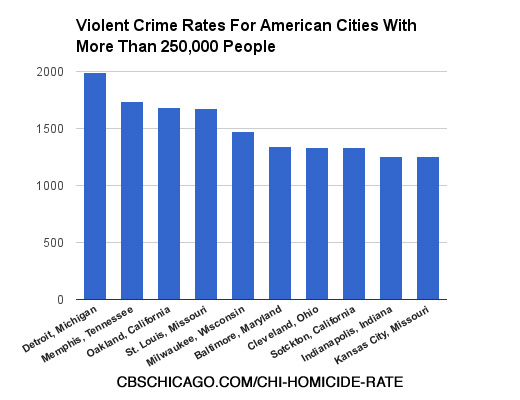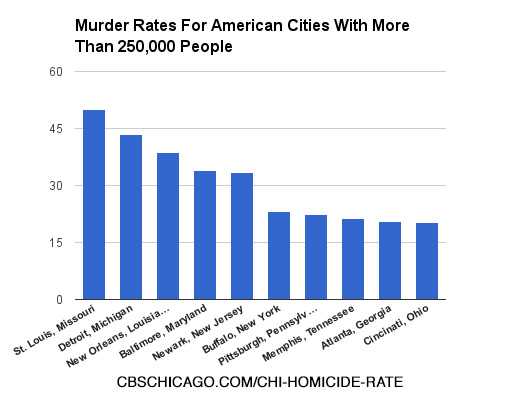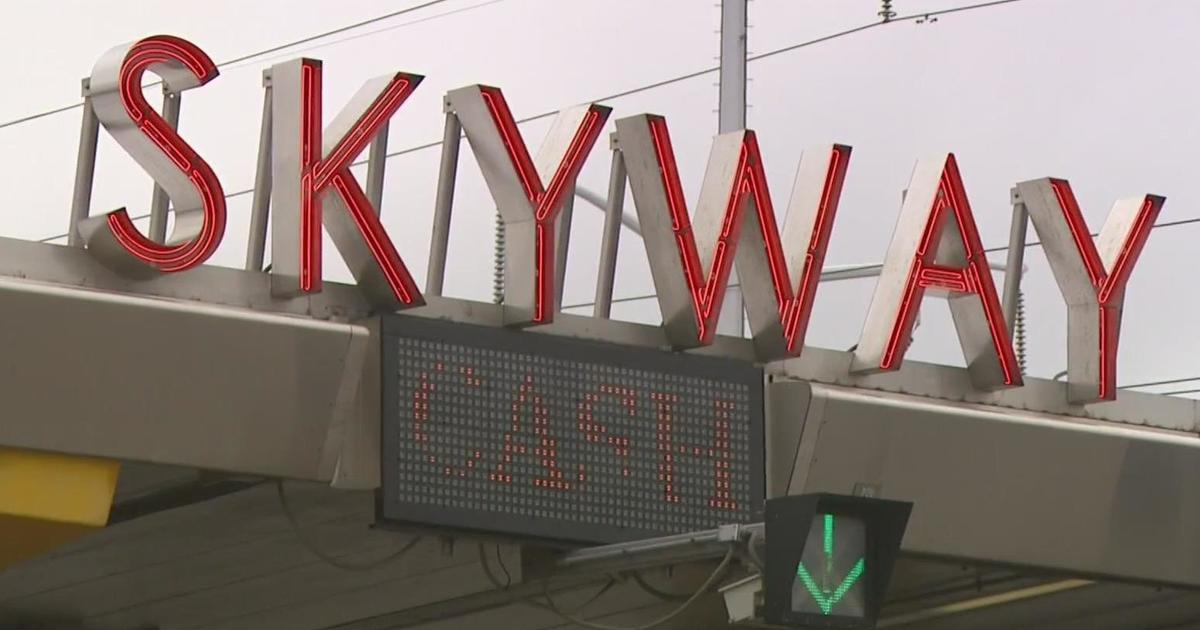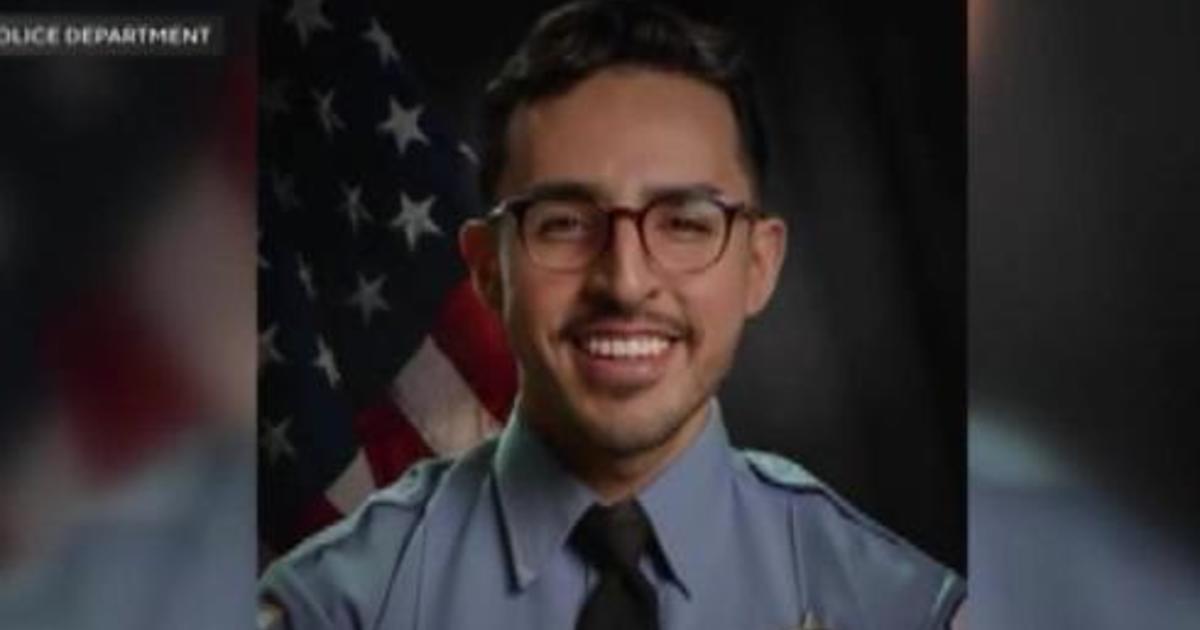FBI's Violent Crime Statistics For Every City In America
The views expressed on this page are those of the author, not CBS Local Chicago or our affiliated television and radio stations.
Every year, the FBI releases the Uniform Crime Report, their statistical interpretation of crime in America. Depending on data given to them by local law enforcement agencies, it's not a ranking of America's cities -- there are no winners, no losers -- but a way for America as a whole and individual cities to track their crime over long periods of time.
With this in mind, I took the FBI's information and looked at the cities with the most violent crime -- murder, rape, robbery and aggravated assault. I did not do this so we could come together and crown a "murder capital" or determine who truly is the "worst." My intention is to share what is essentially a sliver of information about our cities, a handful of numbers that contribute to a much bigger picture.
Ultimately, these rates should be taken with a grain of salt. Alone, they do not represent our cities.
Below, you'll find the cities with the highest violent crime rates. You can see the information for all 9,346 American cities the FBI reported on here.
Violent Crime In America
The country saw a drop in overall violent crime by 1.6 percent between 2013 and 2014. That includes a 2 percent drop in murders, a 6.7 percent drop in robberies and a .7 percent rise in aggravated assaults across America.
In 2014, America had a violent crime rate of 365.5 per 100,000 residents and a murder rate of 4.5.
Violent Crime Rates For Big Cities
There are 76 cities with more than 250,000 people in the FBI's Uniform Crime Report.
Big Cities With The Highest Violent Crime Rates
Detroit, Michigan 1988.63
Memphis, Tennessee 1740.51
Oakland, California 1685.39
St. Louis, Missouri 1678.73
Milwaukee, Wisconsin 1476.41
Baltimore, Maryland 1338.54
Cleveland, Ohio 1334.35
Stockton, California 1331.47
Indianapolis, Indiana 1254.66
Kansas City, Missouri 1251.45
How do the country's largest cities compare? Of America's three biggest cities, Chicago had the highest violent crime rate at 884.26 violent crimes per capita. New York City had a rate of 596.7 and Los Angeles had a rate of 490.71.

Big Cities With The Highest Murder Rates
St. Louis, Missouri 49.91
Detroit, Michigan 43.52
New Orleans, Louisiana 38.75
Baltimore, Maryland 33.84
Newark, New Jersey 33.32
Buffalo, New York 23.22
Pittsburgh, Pennsylvania 22.43
Memphis, Tennessee 21.38
Atlanta, Georgia 20.47
Cincinati, Ohio 20.16
Chicago had a murder rate of 15.09, New York had a rate of 3.93 and Los Angeles had a rate of 6.66 (well, 6.65511 if you don't round to the nearest hundredth).

Violent Crime Rates For Medium Cities
There are 210 cities with 100,000 to 249,999 people in the FBI's Uniform Crime Report.
Medium Cities With The Highest Violent Crime Rates
Birmingham, Alabama 1588.29
Little Rock, Arkanasas 1391.91
Rockford, Illinois 1234.74
Springfield, Missouri 1186.47
Lansing, Michigan 1116.76
Hartford, Connecticut 1104.50
Springfield, Massachusetts 1080.86
Springfield, Illinois 1064.45
New Haven, Connecticut 1054.37
San Bernardino, California 991.67
Medium Cities With The Highest Murder Rates
Jackson, Mississippi 35.39
Birmingham, Alabama 24.52
Baton Rouge, Louisiana 23.11
North Charleston, South Carolina 21.78
Little Rock, Arkanasas 21.69
San Bernardino, California 20.04
Richmond, Virginia 18.92
Dayton, Ohio 18.85
Inglewood, California 17.86
Montgomery, Alabama 17.48
Violent Crime Rates For Small Cities
There are 3,056 cities with 10,000 to 99,999 people in the FBI's Uniform Crime Report.
Small Cities With The Highest Violent Crime Rates
Darby, Pennsylvania 3855.15
East St. Louis, Illinois 3645.89
Forida City, Florida 2771.84
Espanola, New Mexico 2605.45
Benton Harbor, Michigan 2526.46
Opa Locka, Florida 2427.85
Anniston, Alabama 2375.15
College Park, Georgia 2151.56
Gallup, New Mexico 2146.79
Cocoa, Florida 1810.40
Small Cities With The Highest Murder Rates
East St Louis, Illinois 101.8
Chester, Pennsylvania 88.09
Muskegon Heights, Michigan 73.9
Helena-West Helena, Arkansas 61.34
College Park, Georgia 60.89
Lumberto, North Carolina 50.28
Gary, Indiana 47.43
Riviera Beach, Florida 38.87
Eunice, Louisiana 38.73
Trenton, New Jersey 37.95
Violent Crime Rates For Tiny Cities
There are 5,227 with 1,000 to 9,999 people in the FBI's Uniform Crime Report.
Tiny Cities With The Highest Violent Crime Rates
Oceana, West Virginia 4,175.99
Wellston, Missouri 3936.67
Cairo, Illinois 3527.13
Mangonia Park, Florida 3331.62
Lithonia, Georgia 3154.73
West Wendover, Nevada 2677.58
Iowa, Louisiana 2669.21
South Tucson, Arizona 2435.61
Mount Oliver, Pennsylvania 2248.52
Fruitport, Michigan 2173.91
Tiny Cities With The Highest Murder Rates
Weldon, North Carolina 311.72
Welsston, Missouri 256.73
Mangonia Park, Florida 153.77
Alturas, California 152.96
Hawkins, Texas 149.93
Arcola, Texas 122.17
Lockland, Ohio 116.48
Cairo, Illinois 116.28
Lake City, Georgia 113.9
Quitman, Texas 110.44
Violent Crime by Population Group
To give more clarity on what these numbers mean, here are the numbers for the individual population groups, as designed by the FBI. Basically, these groups combine all big cities together, all medium cities together, and so on...
Group I -- American Cities With More Than 250,000 People
Between 2013 and 2014, there was a 1.3 percent drop in violent crimes and a .4 percent rise in murders in Group I (what I've been calling big cities). With a population of 57,577,457, Group I had a violent crime rate of 706.05 and a murder rate of 9.27 for 2014.
Group II -- 100,000 to 249,999 People
Between 2013 and 2014, there was a .8 percent drop in violent crimes and a 1 percent rise in murders in Group II (what I've been calling medium cities). With a population of 31,966,637, Group II had a violent crime rate of 443.94 and a murder rate of 5.64 for 2014.
Groups III, IV and V -- 10,000 to 99,999 People
Between 2013 and 2014, there was a 3.13 percent drop in violent crimes and a 2.57 percent drop in murders in Groups III, IV and V (what I've been calling small cities). With a population of 91,614,990, Groups III, IV and V had a violent crime rate of 285.93 and a murder rate of 2.98 for 2014.
Group VI -- Under 10,000 People
Between 2013 and 2014, there was a 1.1 percent drop in violent crimes and a 5.8 percent drop in murders in Group VI (what I've been calling tiny cities). With a population of 23,250,297, Group VI had a violent crime rate of 274.11 and a murder rate of 2.46 for 2014.
Methods, Quirks And Caveats
I made some very specific choices when presenting the above numbers. Not everyone's going to agree with those decisions.
If you don't, feel free to go straight to the source, the FBI, or to take a look at the spreadsheet I assembled from the FBI's data.
Totals vs Rates
I decided against including violent crime totals in this article, though they exist in the spreadsheet I made for this article. Considering the vast differences in population among American cities, crime totals are misleading. Bigger cities will have higher violent crime totals, smaller cities will have lower totals. This is seen most clearly by the fact that the five biggest cities in America -- New York, Los Angeles, Chicago, Houston and Philadelphia -- are also the five cities with the most violent crime. With that said, while New York City (which has the largest population total), has the largest violent crime total, Los Angeles (second largest population total), has a smaller violent crime total than Houston and Chicago, despite the fact Houston and Chicago have fewer people.
I instead used the violent crime rates per 100,000 people when looking at the numbers of the above cities. Rate per capita takes population into consideration, leveling the playing field between cities with drastically different population numbers. When you look at cities' violent crime rates per 100,000 people, the five cities with the highest totals --New York City, Los Angeles, Chicago, Houston and Philedelphia -- disappear from the top of the list.
They have the biggest numbers, yet, considering their populations, have a lower number of violent crime occurrences than the cities with the highest violent crime rates.
Population Groups
I also separated cities by population. Crime rates may be better than totals, but a single murder in a small town yields a drastically different effect on a crime rate than a single murder in a large city. Because of this, I've divided cities into the following categories: big cities (250,000 people and over), medium cities (100,000 - 249,999 people), small cities (10,000 - 99,999 people), and tiny cities (1,000 - 10,000 people).
Towns with fewer than 1,000 people are not included in this article. For some of these towns, a single murder would catapult their murder rate into the hundreds, which is pretty drastic.
These towns were left in the spreadsheet with the data though.
Rape Definitions
As it turns out, collecting accurate data from every law enforcement agency across America is not an easy feat. Many quirks exist within the data collected by the FBI, with the differing definitions of rape being the biggest at the moment.
Recently, the FBI changed their definition of rape to encompass more sex crimes than previously, meaning the number of rapes by the new definition is higher than the number of rapes by the old definition. While Illinois and Chicago have been using a definition similar to the FBI's new definition for decades, many places were not. It looks like a great deal of states and cities have switched to the new definition, but a fairly large chunk have not.
For those using the old definition, their violent crime totals and rates are likely smaller than they would be if they were using the new definition. The change wouldn't likely drastically change the violent crime total or rate of a city, but it definitely changes the rape total and rate.
How much of a difference is there between the definition? Nationally, the older, more narrow definition counted 26,994 rapes in America in 2013. The newer definition counted a total of 38,250. For America as a whole, the new rate counted 41 percent more crimes than the old rate in 2013. With that said, that gap is likely to vary significantly from city to city.
Numbers Don't Lie... Probably?
Numbers don't lie, but people often use numbers to support their lies.
The numbers in this article represent a year, sometimes two years, which is a relatively short amount of time. They do not represent the whole picture when it comes to a city's crime, let alone the whole city, or how a city has dealt with its crime over long periods of time. For a better view of a city's crime, you need to study the FBI's statistics going back decades. And even then, the changes in crime won't necessarily reflect all the changes a city goes through over time.
Most of all, any numbers you are able to find won't be able to completely and accurately portray your city. It takes a deep understanding of not only the statistics behind crime and poverty, but a solid grasp on the history of a place to begin to understand the true character of the place you live.
So, you know, please don't make a million "the most dangerous cities in America" lists without providing any context of what those numbers mean or how misleading they can be.
Mason Johnson is a Web Content Producer for CBS Chicago. You can find him on Twitter.
Sources: FBI Uniform Crime Report, especially Offenses Known to Law Enforcement by State by City; you can view the full statistics we used here.



